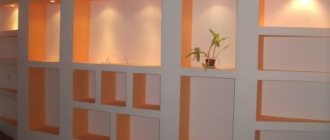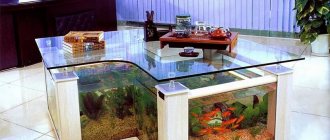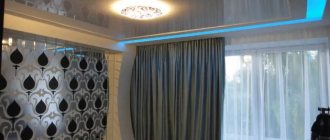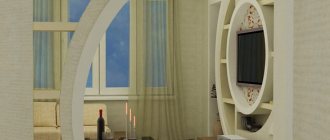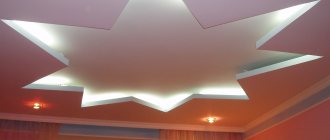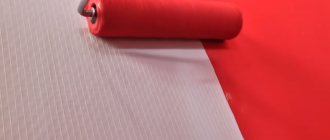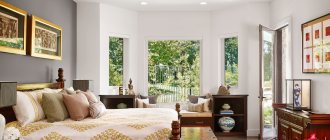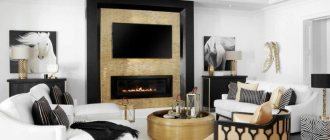There are a great variety of modern finishing materials and design options today. But only some solutions can cause real admiration. One of the ways to decorate the interior wall of an apartment or house is an aquarium in the form of a partition. This interior element does not go out of fashion for a long time. It can be used in rooms for various purposes, be it a living room, a bedroom or even a dining room.
Aquarium and its purpose
An aquarium in a modern home becomes a natural embodiment when a person so needs harmony and tranquility in the bustling passage of time. If we consider this part of the interior from the point of view of the teachings of Feng Shui, it can be noted that it is a carrier of the water element. In this regard, many people install aquariums, guided by the fact that they help attract material wealth.
If the room is small, then using the described technique you can give it lightness and volume. You can complement this part of the room with lighting fixtures, which will focus attention on the built-in aquarium. In addition, quite often designers resort to such modernization of a room in order to hide defects in surfaces or finishes, because all attention will be focused on that part of the space that looks most advantageous.
Types and features of aquariums
An aquarium built into a partition can be classified according to several criteria - purpose and shape. According to the first factor, the decor described can be decorative, spawning, quarantine and age-related. But if we are talking about a partition, then you should take into account only decorative aquariums. They can be divided into several more types, among them:
- biotope;
- collectible;
- species.
The former must correspond to the natural habitat, while the latter provides for the presence of only a few species of fish. As for the shape, the partition in the interior usually provides for the presence of rectangular and asymmetrical aquariums, while oval, round and cylindrical ones are usually installed separately.
Selecting a location
Each partition is suitable for installing an aquarium, but a load-bearing wall cannot be drilled for this purpose. Among the main requirements, the correct choice of location should be highlighted. This should not be the part of the room that is exposed to the sun most of the day.
If you are considering the idea of an aquarium in the living room, then it is important that the interior of the room does not include a fireplace or other heating device nearby. Typically, such aquariums have an impressive weight, so before starting installation work it is important to make sure that the support is quite strong, because it must bear the load.
Aquarium materials
The main material is, of course, glass. But all other parts (for example, internal filling and frame) can be made from:
- wood;
- glass;
- plastic;
- ceramics;
- stone;
- metal
The latter is used quite rarely, because it undergoes oxidation. In order to eliminate such processes, the elements are coated with special compounds. But even with this, metal elements lose their attractive appearance over time and require replacement. The internal filling is usually made of plastic.
When choosing stones, you should pay attention to:
- granite;
- flint;
- quartz;
- basalt;
Attention! It is important to eliminate lime and also ensure that the elements will not interact with the water in any way, such as staining or polluting it.
When choosing a base material, it is important to consider quality. The glass must be damaged, have a uniform color and not contain harmful impurities released into the liquid. When choosing internal filling, pay attention to ceramic products that act as decorations. If there are coastal areas, you can use wood for decoration. Willow and alder trunks are perfect.
The basis may be acrylic or plexiglass, which is called organic. An alternative solution is silicate glass. By choosing organic glass, you ensure strength and reliability. This material does not interact with water in any way, but has one important drawback - not so high resistance to mechanical stress. The surface can be easily damaged, and over time it even becomes cloudy.
Frameless tanks are made from silicate or organic glass. If the size is impressive, you should choose a frame structure that has metal frames. It is impossible to store such a container without water, as it may become unusable, and the putty will dry out and be destroyed. Seamless plexiglass containers look most impressive. They can protrude beyond the partition and have rounded corners and curved walls.
Shape and dimensions
The aspect ratio of the container will form a certain shape. The ideal configuration for keeping fish is a cube configuration with a side of 50 cm. Such an aquarium holds 125 liters of water. But such a design is rarely used, because the partition will be filled to a limited height.
Usually structures with a small depth and significant height are built into the wall, but they lose in contemplation. It is also important to take into account the peculiarity of the behavior of fish, which by nature are quite shy. If you install a cubic shape, then most of the time you will observe the internal contents, but not the living inhabitants.
In terms of size, rectangular aquariums are quite popular, with the height being higher than the width. You can build a 20 liter aquarium into the wall, which will be easier to care for. Moreover, the partition itself may also have functional niches or drawers.
It is important to consider that when choosing an impressive height that looks more harmonious in the wall, you will have to think about the internal filling, otherwise the water world will look rather sparse in the upper part. Typically, experts do not talk about clear capacity parameters. Therefore, you can choose the dimensions yourself, taking into account the dimensions of the partition.
How to choose a design for premises for different purposes
When choosing a container, you need to take into account the purpose of the room and its size. For example, large aquariums are not suitable for the hallway area, especially if free space is limited. It is better to prefer a miniature version, but choose a non-standard shape. So, aquariums in the form of cylindrical structures look good.
But if there is not much free space, in addition to the container itself, you will also need to think about a place for equipment, namely a cooler and a filter. Some rooms are not at all suitable for such an interior element, since the only place for installation is near the window, and it is extremely undesirable, because algae and fish should not be exposed to sunlight that is harmful to them.
The purpose of the aquarium in the living room interior
An aquarium is not only a decorative element. With its help you can solve several problems in room design:
- create a stylish and unique interior;
- make the environment more comfortable.
By installing an aquarium in your living room, you will add more than just charm. With his help:
- rid your household of negative emotions;
- improve the mood of those around you;
- normalize the nervous system through systematic observation of water and fish life.
- improve the psychological climate in your family.
Built-in narrow and long aquarium in the living room
If you decide that your living room simply needs this accessory, first decide on the type and design.
Where to place the aquarium
Such a structure must be installed in a place in the home that has sufficient free space. Usually this is the living room or bedroom. Despite all the harmony, an aquarium does not always look advantageous where it does not belong, so you need to carefully think through the style and select the shape.
Kitchen
Here, a small container will look most natural, which will give the room comfort and coziness. If the area of your home is large, you can zone the space in the dining room area, separating it from the kitchen. Here the design will fit well into the entire niche.
Living room
This installation option is classic. The main thing is to choose a design that matches the style of the interior. The partition can be decorative, then it only serves to install the aquarium and does not reach the ceiling. Today, they even sell ready-made walls with aquariums that are installed on site. Often the living room borders on the kitchen area; in this case, you can use a narrow but rather tall aquarium.
Bedroom
Such a piece of furniture is rarely installed in a recreation area, because the operation of its equipment is accompanied by a certain noise. When choosing content, you should avoid flashy bright items that will unnecessarily attract attention. The color of the fish should also be restrained.
Children's
This method of decorating a nursery is rarely used, because even furniture there is usually installed with soft corners, not to mention an object that may pose a danger to the child. But if the child is already growing up, the aquarium will be a great way for him to relax after a hard day at school. To prevent falls, you need to consider a secure base and good fall protection when installing.
Hall
When the size of the corridor is not too limited, you can use a technique such as installing an artificial fish habitat. And the lighting can become a night reference point for household members.
Bathroom
Here the aquarium will look most harmonious, and if it is also built into the wall next to the shower, water treatments will become even more enjoyable. Often artificial ponds in this part of the house are also supplemented with speakers, which will add audio accompaniment to the visual pleasure.
Other suitable room options
The above premises are limited to an ordinary apartment or small house. But if you are the happy owner of a cottage where there are many other rooms, you can also think about where else to install the aquarium. You can consider the option of a wall next to the stairs or a gap between the flights. When there is a recreation room with a swimming pool in the basement, a transparent large container with fish can be an excellent decoration and addition to the space.
How to build an aquarium into a wall?
Undoubtedly, an aquarium in the interior cannot leave anyone indifferent. Moreover, the aquarium makes the interior memorable and gives it an incomparable charm. Today, the presence of an aquarium in the living room of a cottage, apartment, office or restaurant has become a mandatory part of the interior design. We could go on and on about the aesthetic and therapeutic qualities of aquariums, but quite a lot has already been said about this. We decided to devote this article to describing methods for installing large aquariums and their installation in the interior.
Caring for an aquarium, with modern equipment, is not a problem today. And the larger this aquarium is, the easier and less often there will be a need for its maintenance. Modern technologies for the production of aquariums make it possible to produce frameless containers of enormous sizes, and if for most aquarium enthusiasts until recently the upper limit of the height of an aquarium was only 60 cm, today it has grown by more than a meter. However, not everything is so simple, since along with the height of the aquarium, the load on the base has also increased. Even an empty aquarium with a height of more than a meter will have a lot of weight, since thick glass is used for its manufacture, up to 20 mm or more. The load increases even more when filling the aquarium with soil, decorations and water. The total load on the base can thus increase to 160 kg/sq.m. dm.
If you entrust the installation of an aquarium to unskilled workers, then the risk of a disastrous outcome is almost 100%, since when installing a large aquarium there are a lot of nuances that even an experienced builder, not being an expert in this field, cannot know about. However, it is worth noting that such workers willingly take on installation work, assuring that there is nothing complicated about it. In fact, this is not entirely true, since in the case of an aquarium, we are talking about 500, 800, and sometimes more than 1000 liters of water, which can end up on the floor, leading to serious losses. At the same time, if the installation technology is followed correctly, the aquarium will last 10 years or more without causing a single leak.
There are several ways to install aquariums, including integration into an interior wall (the aquarium can be seen through), integration into a wall with the back edge closed, installation of the aquarium on a pedestal or on a powerful slab mounted in the wall like a balcony.
| Pass-through aquariums look impressive only in the case of intensive filtration and ultraviolet sterilization of water, because... otherwise, even a slight clouding of it can negate the entire effect. |
The same applies to the case when it is intended to keep in a through-flow aquarium fish that like to dig in the ground, for example, koi carps and goldfish, which are often transferred from a summer pond to a home aquarium for the winter. An aquarium with a closed back wall will look much better in the interior and the slight cloudiness that occurs as a result of the vital activity of carp, goldfish and other rummagers will be almost unnoticeable. Of all the features of installing an aquarium, the most important is the preparation and arrangement of the place that will serve as the foundation. If you plan to build an aquarium into the body of the wall, then you need to pay attention to what this wall is made of. Of course, it is better if the built-in aquarium is planned at the construction design stage and aquadesign specialists make their own adjustments there. However, you can also integrate an aquarium into an already decorated interior.
To do this, as already mentioned, you need to make sure that the wall, part of which will serve as the base for the aquarium, is made of reliable material. For plasterboard walls under aquariums, welded frames are made from profiled steel, maintaining the rigidity and safety margin of their structure. Both in the case of building aquariums into existing walls, and when building new walls, it is necessary to give the base where the aquarium will be installed a perfectly flat horizontal surface. The bottom of the aquarium (especially a large one) experiences enormous loads and, if the base is uneven, will follow its shape. If the curvature turns out to be critical, then the bottom will certainly burst. And if the unevenness of the base is insignificant, this will also affect the service life of the aquarium, and all this time the risk of cracking the bottom will remain quite high.
The final leveling of the base area of the aquarium must be done with non-shrinking compounds. It is best to use cement-sand mortar for rough leveling, and cement-based putty for finishing. To isolate the bottom of the aquarium from the base, use a polyisol gasket 4-5 mm thick. It perfectly distributes the load and levels out the smallest irregularities. Installing the aquarium directly on the base (without a gasket) is strictly prohibited, because... The smallest grain of sand can cause the bottom to crack. Another important point is to allocate space for aquarium equipment and organize access to the aquarium for maintenance. As a general rule, the taller the aquarium, the more space you need to leave on top of it. The minimum free opening at the top for a 60 cm aquarium is considered to be 40 cm. Thus, the height of the opening in this case will be equal to 1 m.
A good solution for non-through aquariums would be to make it through, but with a decorated back wall. This will make it possible to carry out all technical manipulations from the rear side, while leaving the façade of the aquarium untouched. At the design stage, it is necessary to lay water, drainage and electrical communications, as well as provide space for a canister filter, UV sterilizer and other aquarium equipment. In the last decade, marine aquariums have become increasingly popular among ichthyofauna lovers. They can be freely installed into the interior in a pass-through manner, because As a rule, they always have crystal clear water. If until recently, having a piece of a coral reef with bright sea fish in your home was a dream, today it is a completely feasible task. Modern equipment for marine aquariums makes it possible to create optimal living conditions for their inhabitants and even grow live corals. Freshwater and, especially, marine aquariums built into the interior will certainly become the center of attention for all guests and visitors, and the creative solutions of the designers will further emphasize the special living aesthetics and energy of these beautiful underwater worlds.
So, in order to properly integrate an aquarium into the wall, you need to consider:
• The larger the aquarium, the easier and less maintenance it requires • The surface of the wall on which the bottom of the aquarium is installed must be perfectly flat and level with the horizon
• The clearance above the aquarium is 40-50% of the height of the aquarium, but not less than 40cm
• Pass-through aquariums require more thorough filtration
• Aquariums with a volume of more than 500 liters should preferably be equipped with water supply and sewerage
Author: M.Tamilin specially for nemo.by
Basic options for using and designing aquariums
You should not assume that an artificial pond in a partition is a limited way of designing a space. The aquarium can be built not only into a wall, but also into a column and even a clock.
Built into the partition
When this method of designing a partition is chosen, a false wall is usually installed, because in an existing stationary structure it is quite difficult to make an appropriate hole for installing the structure. But if you still want to use such an opening, you can leave a gap on top, which will further lighten the space and make the atmosphere more airy.
Corner designs
Maximum free space does not always look advantageous. Sometimes an area needs to be filled, and this can be done with a corner aquarium. It can be supplemented with functional cabinets, which are most convenient to use in the dining room or living room.
Part of the table
If you have such furniture, then not a single visitor to your home will remain indifferent. Unsightly equipment can be hidden in the legs, which are located on the sides. Such an aquarium will become the center of attention of your home and will distract the eye from the less attractive areas of the room.
Interior partition
You don’t always want to delimit space with monolithic walls, which are difficult to construct and require the installation of doorways. If you want to make the room as modern and colorful as possible, you should install a partition with an aquarium in the middle part. The structure is usually illuminated from above, which makes it appear to be hanging under the surface of the ceiling.
Column aquarium
This piece of furniture is suitable for those who have a small apartment, but want to add aquatic inhabitants to it. The column can be functional and support the ceiling, or mobile.
Aquarium clock
If there is even less space where you could place the container, you should purchase an aquarium in the form of a clock. They will not only allow you to relax and escape from the busy rhythm of work, but will also decorate the interior.
Alternative solutions for aquariums
When there are no plans to install a partition, and there is absolutely no space for it, you can use alternative solutions. For example, an aquarium can be panoramic or designed as a wall decoration.
Niche for one-sided design
The most important points in this matter are two nuances. You must create a solid foundation that will bear the load. This is exactly the place where the aquarium will be located. You cannot use plasterboard or a profile system for this purpose.
However, you can use aerated concrete or brick. Drywall will allow you to form only the upper part, which will not be subject to loads. The upper part needs to be strengthened. If you will form a niche in a brick wall, you will need insurance for the upper bricks in the form of a crossbar made of a metal corner.
Aquarium ideas for the living room
To diversify your interior design, you can use interesting techniques, for example, placing an aquarium in such a way that it looks like part of the kitchen unit. You can build it into a partition between two rooms, but do not make it all the way to the ceiling. Such an aquarium can become an extension of the back of the sofa, which zones the space. A technique that involves the appearance of not two opposite, but two adjacent walls looks very interesting. Then you can watch the fish from different angles.
